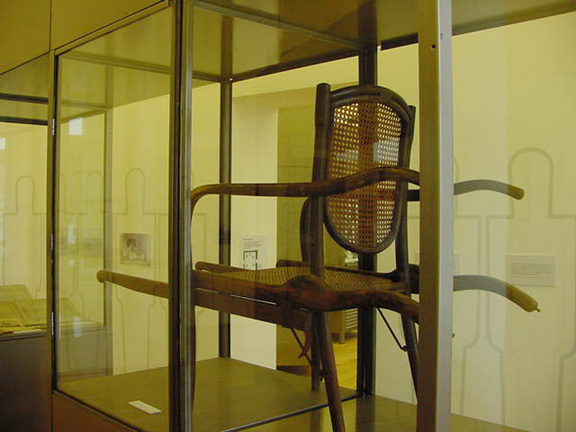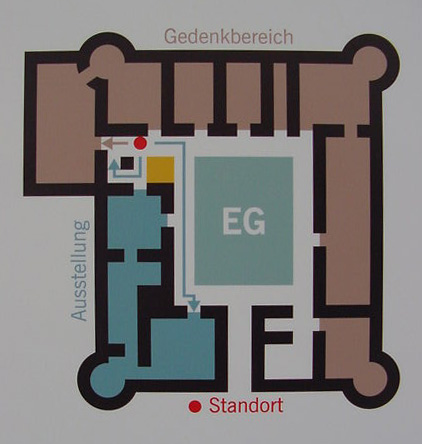Hartheim Castle Exhibits On display in a glass case in the exhibit area is this very old chair with no wheels in which a handicapped person had to be carried by two people.  The location of the exhibits at Hartheim Castle is indicated by the blue area on the map shown above. Visitors can enter the Memorial Site from two entrances designated by the two red dots. There is an elevator by the entrance shown at the top of the map; the exhibits are on the first two floors of the four-story castle; the two upper floors have seminar rooms. The title of the exhibits at Hartheim Castle is "Wert des lebens" which means "the value of life" in English. This is also the theme of the Memorial Site, which promotes the concept that handicapped students should be mainstreamed in the schools. The exhibits put the issue of the handicapped into a positive perspective; they are shown as being "worthy of life" and as people who should be treated with respect. Before sending each victim into the gas chamber at Hartein Castle, the Nazis took their photograph. Instead of showing the photographs of the pathetic, institutionalized people who were killed at Hartheim, there are present-day photos of 3 handicapped students and two mentally or physically challenged adults who are leading normal lives. Two photos from this exhibit are shown below. 
 The Nazi euthanasia program began in August 1939 when a five-month-old baby boy, named Gerhard Kretschmar, was "put to sleep" after the boy's father made a request to Adolf Hitler for a "mercy killing." Hitler sent his personal physician, Karl Brandt, to conduct a medical examination before giving his permission for the infant to be given a lethal injection. Karl Brandt was put on trial at Nuremberg in the "Doctor's Trial." In his testimony, Brandt said that the baby's father, Richard Kretchmar, had written to Hitler's office in early 1939, asking for permission to kill his blind and deformed son. The following quote is from Brandt's testimony: The father of a deformed child wrote to the Fuhrer with a request to be allowed to take the life of this child or this creature. Hitler ordered me to take care of this case. The child had been born blind, seemed to be idiotic, and a leg and parts of the arm were missing. An estimated 8,000 deformed children were killed in the same manner, some without the consent of their parents. The Nazi euthanasia program was code-named T4, named after the address on Tiergartensstrasse in Berlin; this was the street address of the Privatkanzlei des Führers run by Philip Bouhler. By the beginning of 1940, six hospitals were involved in these "mercy killings." Records discovered in 2003 show that the euthanasia program was eventually extended to 296 medical facilities in Germany, Austria, the Czech Republic and Poland where mentally and physically disabled children and adults were injected, gassed or starved to death. The Nazis made a documentary film of
some of the adult victims before they were killed; this was an
attempt to justify the murder of disabled and deformed people.
Many of the victims, who were crippled by a birth defect called
spina bifida, are shown in the film, walking on all fours. This
film is not shown at the Hartheim Memorial Site. ContinueBack to Hartheim indexHome |